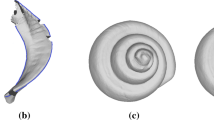Abstract
Due to the increasing interest in 3D models in various applications there is a growing need to support e.g. the automatic search or the classification in such databases. As the description of 3D objects is not canonical it is attractive to use invariants for their representation. We recently published a methodology to calculate invariants for continuous 3D objects defined in the real domain \({\mathbb R}^3\) by integrating over the group of Euclidean motion with monomials of a local neighborhood of voxels as kernel functions and we applied it successfully for the classification of scanned pollen in 3D. In this paper we are going to extend this idea to derive invariants from discrete structures, like polygons or 3D-meshes by summing over monomials of discrete features of local support. This novel result for a space-invariant description of discrete structures can be derived by extending Haar integrals over the Euclidean transformation group to Dirac delta functions.
Access this chapter
Tax calculation will be finalised at checkout
Purchases are for personal use only
Preview
Unable to display preview. Download preview PDF.
Similar content being viewed by others
References
Arbter, K., Snyder, W., Burkhardt, H., Hirzinger, G.: Application of Affine- Invariant Fourier Descriptors to 3-D Objects. IEEE Trans. on Pattern Analysis and Machine Intelligence PAMI-12(7), 640–647 (1990)
Burkhardt, H., Siggelkow, S.: Invariant features in pattern recognition – fundamentals and applications. In: Kotropoulos, C., Pitas, I. (eds.) Nonlinear Model-Based Image/Video Processing and Analysis, pp. 269–307. John Wiley & Sons, Chichester (2001)
Ronneberger, O., Burkhardt, H., Schultz, E.: General-purpose Object Recognition in 3D Volume Data Sets using Gray-Scale Invariants – Classification of Airborne Pollen-Grains Recorded with a Confocal Laser Scanning Microscope. In: Proceedings of the International Conference on Pattern Recognition, Quebec, Canada (September 2002)
Schulz-Mirbach, H.: On the Existence of Complete Invariant Feature Spaces in Pattern Recognition. In: Proc. of the 11th International Conference on Pattern Recognition, Conference B: Pattern Recognition Methodology and Systems, Den Haag, vol. II, pp. 178–182 (1992)
Schulz-Mirbach, H.: Anwendung von Invarianzprinzipien zur Merkmalgewinnung in der Mustererkennung. PhD thesis, Technische Universität Hamburg-Harburg, Reihe 10, Nr. 372, VDI-Verlag (February 1995)
Schulz-Mirbach, H.: Invariant features for gray scale images. In: Sagerer, G., Posch, S., Kummert, F. (eds.) 17. DAGM - Symposium “Mustererkennung”, Bielefeld, pp. 1–14. Reihe Informatik aktuell, Springer. DAGM-Preis (1995)
Author information
Authors and Affiliations
Editor information
Editors and Affiliations
Rights and permissions
Copyright information
© 2004 Springer-Verlag Berlin Heidelberg
About this paper
Cite this paper
Burkhardt, H., Reisert, M., Li, H. (2004). Invariants for Discrete Structures – An Extension of Haar Integrals over Transformation Groups to Dirac Delta Functions. In: Rasmussen, C.E., Bülthoff, H.H., Schölkopf, B., Giese, M.A. (eds) Pattern Recognition. DAGM 2004. Lecture Notes in Computer Science, vol 3175. Springer, Berlin, Heidelberg. https://doi.org/10.1007/978-3-540-28649-3_17
Download citation
DOI: https://doi.org/10.1007/978-3-540-28649-3_17
Publisher Name: Springer, Berlin, Heidelberg
Print ISBN: 978-3-540-22945-2
Online ISBN: 978-3-540-28649-3
eBook Packages: Springer Book Archive




